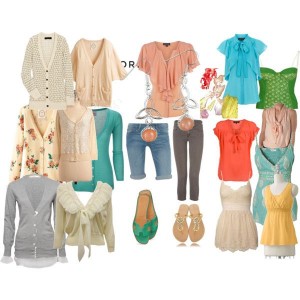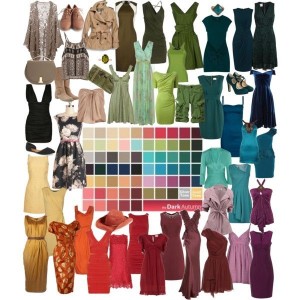The other day, a friend of mine commented that it was the second time in our eight-year friendship that she had seen me wear lipstick. It’s true that I never used to wear lipstick, or if I did, the shade was so nude you wouldn’t even notice it. I would buy the pinks and reds generally recommended for fair-skinned blondes, but I would never wear them out of the house. When I did, I would get comments like, “Oh, you’re wearing LIPSTICK.” I didn’t understand how to choose lipstick that I would actually wear out of the house and feel comfortable in.
Same with colors in clothes in general. Most of my wardrobe was–and still is, since replacing an entire wardrobe takes time and money–black and gray. When it came to adding color to my wardrobe, I didn’t even know where to begin. How could I be sure that something would flatter me?
There were a lot of missteps along the way, and for a good reason. Most of what I’ve heard all my life is in line with the advice for Light Summer and Light Spring: turquoise, pinks, lighter colors. Nothing too dark. When I started looking at color analysis, I assumed that this was my fate. I resigned myself to bright and light spring colors.

(Source)
But once I actually had a Light Spring fan in my hands, it was clear that it was bad. Really bad. It was a long process, but I found myself staring at Dark Autumn.
It didn’t seem to make much logical sense. How could my leading characteristic be darkness when I was so light to look at? But the colors worked, even notoriously difficult colors like yellow. Putting together Dark Autumn colors is easy and feels right. Dark Autumn lipsticks, even some that look very dark in the tube, look right on my face. I’ve gone from never wearing lipstick to having it often be the only makeup I’ll put on.

(Source)
The colors in the Dark Autumn palette are so unexpected for my natural coloring that, although they are colors that I am drawn to and appeal to me, if I hadn’t come to Dark Autumn through color analysis, I never would have reached for them myself. It would never have occurred to me that this is the color family that suits me. You’ll never find a picture of someone with my coloring as a celebrity example of a Dark Autumn palette–although blonde hair with a lot of depth, eyes that are a deep mix of green/blue/gray with spots of yellow, and pale skin are fairly common among draped Dark Autumns in 12-season analysts’ portfolios.
What color analysis has enabled me to do is understand how to use color. I have a fairly strong background in art, so I know how to use color more generally, but I was at a loss at how to use it on myself. It freed me from literal my-lips-but-better colors and always selecting black or gray.
Seasonal analysis can seem quaint and old fashioned to those whose only reference is something like this video. But contemporary color analysis enables us to pinpoint exactly which colors flatter us and bring out our best selves. It enables us to select clothing and makeup with confidence, and more practically, it creates a wardrobe where everything coordinates perfectly.
————————————————————————————————–
Know your type in several systems but having trouble putting it all together? My workbook can help.
lux
November 6, 2015 at 1:00 pmWhat I love about color analysis are make up recommendations lists for each season. Really helpful. Although I seem ‘precisely’ to belong nowhere in 12 system, I find my best cosmetics on SS and DW lists. I learned that darkest SS lipsticks and most delicate DW lipsticks work best. I noticed some of them appear even on both lists, so than I can be sure it’s something for me At least I know where to search. 🙂
What I hate about color analysis are celebrity examples, you mentioned. They are doing a lot of wrong. Not only I have never found a pic of someone with my coloring in SS or DW groups, but I have never found a celebrity example with my coloring… The first useful example of someone who shares my features I found thanks to your blog. 🙂 It was a client L,very light skinned woman with visible contrast, though muted a bit : http://www.bestdressed.us/blog/2014/12/29/the-brightness-of-dark-winter-or-how-dark-winter-can-appear-to-be-bright-spring#comments-outer-wrapper=
And although, I still think I’m a summer type, I realized why BW (I was diagnosed as BW in the past) colors were so bad on me and why lighter SS colors make me look so pale, unhealthily and uninteresting, and why people love me in black. That’s because, I’m soooo shaded…
PS.Love your blog. It gave me much more than any of my ca. 😉
stylesyntax
November 6, 2015 at 1:51 pmIt’s not uncommon for people to be able to draw makeup from various seasons–which is why lipstick draping isn’t the best route to go. Colors can also look different on different people due to bod chemistry. I have makeup that is cross-listed for DW and TA, for example.
lux
November 6, 2015 at 2:39 pmThat is so complicated. And fascinating! How to explain this? Is it yours lip’s warmth what transform DW lipsticks, canceling their coolness?
stylesyntax
November 6, 2015 at 3:59 pmI think that plays a role, but my lips are actually fairly pale and don’t have much pigment. DA lipsticks will turn cooler on me also, and brown tones will look a little more pink. It also has to do with your pH.
Shawna
November 6, 2015 at 9:43 pmThis is a great post and I relate to what you are saying here because I feel very comfortable in the Kibbe category, or perhaps I will say Kibbe inspired category where I have settled and even though my test results always come out as soft classic, I am more at home in soft natural and could not fit myself into the soft classic mould. I think that my personalised version is some sort of blend, some sort of classicified soft natural and that’s why it works. It’s tailored to me personally. Also, way back in the eighties I was typed as a Winter by a Colour Me Beautiful practioner but I always knew it was wrong. I am a Soft Summer Deep which means I also look fine in Deep Winter Soft as they are similar. I am predominantly soft and cool, but the original Colour Me Beautiful system didn’t allow for soft, and I was easily typed as cool but as I am not a blonde and the pastels don’t suit me, Summer was ruled out. I instinctively wanted the soft cool colours and my makeup choices, the colours that looked best on me were soft summer colours. I think there is much to be said for our own instincts.
stylesyntax
November 6, 2015 at 9:57 pmI think FG was very instinctual to me, and it perfectly aligns with my tastes–but I never would have ended up in DA colors if I hadn’t started looking at analysis. While I do love the colors, it’s simply an avenue that I thought was closed to me due to being blonde and pale. I had always just assumed that the colors in the Light palettes were the correct ones, even though I didn’t particularly care for them.